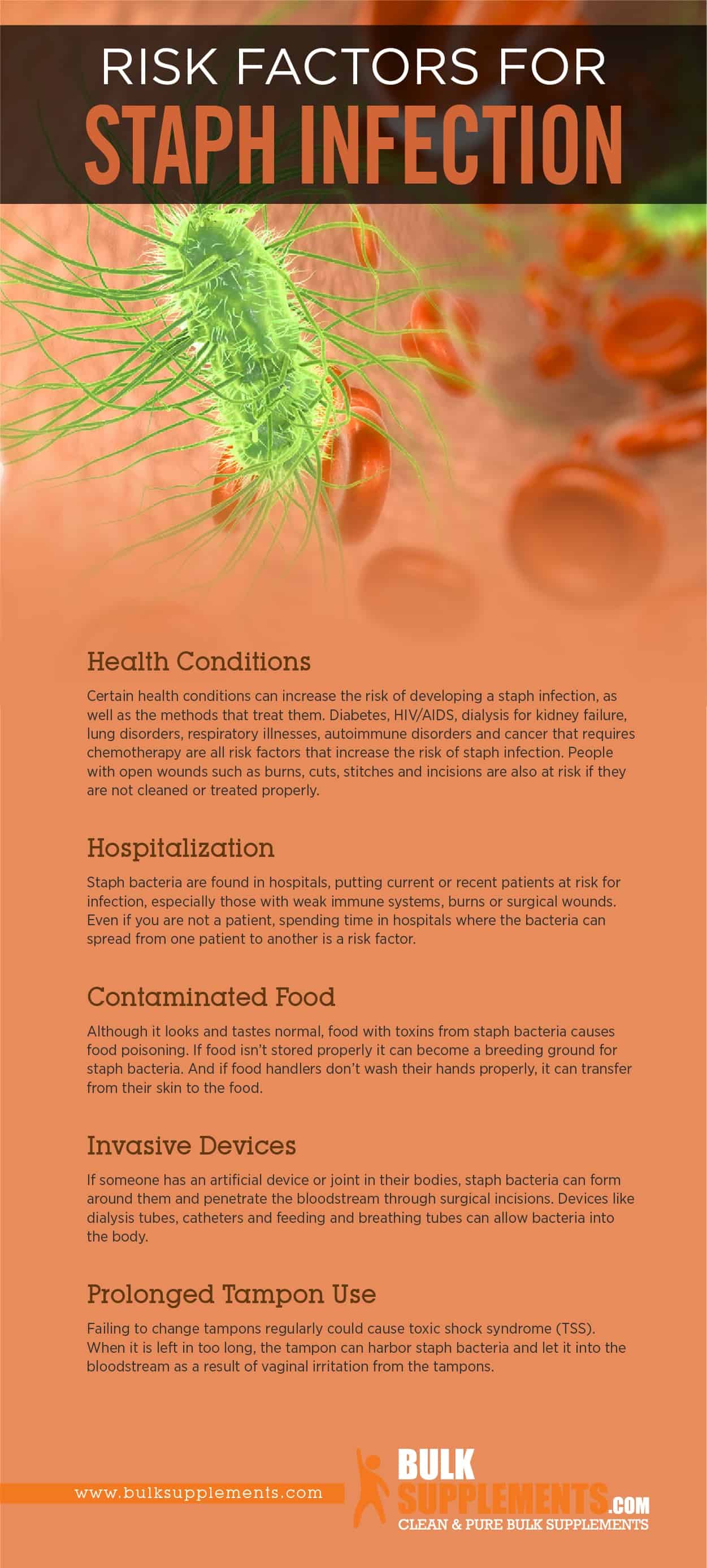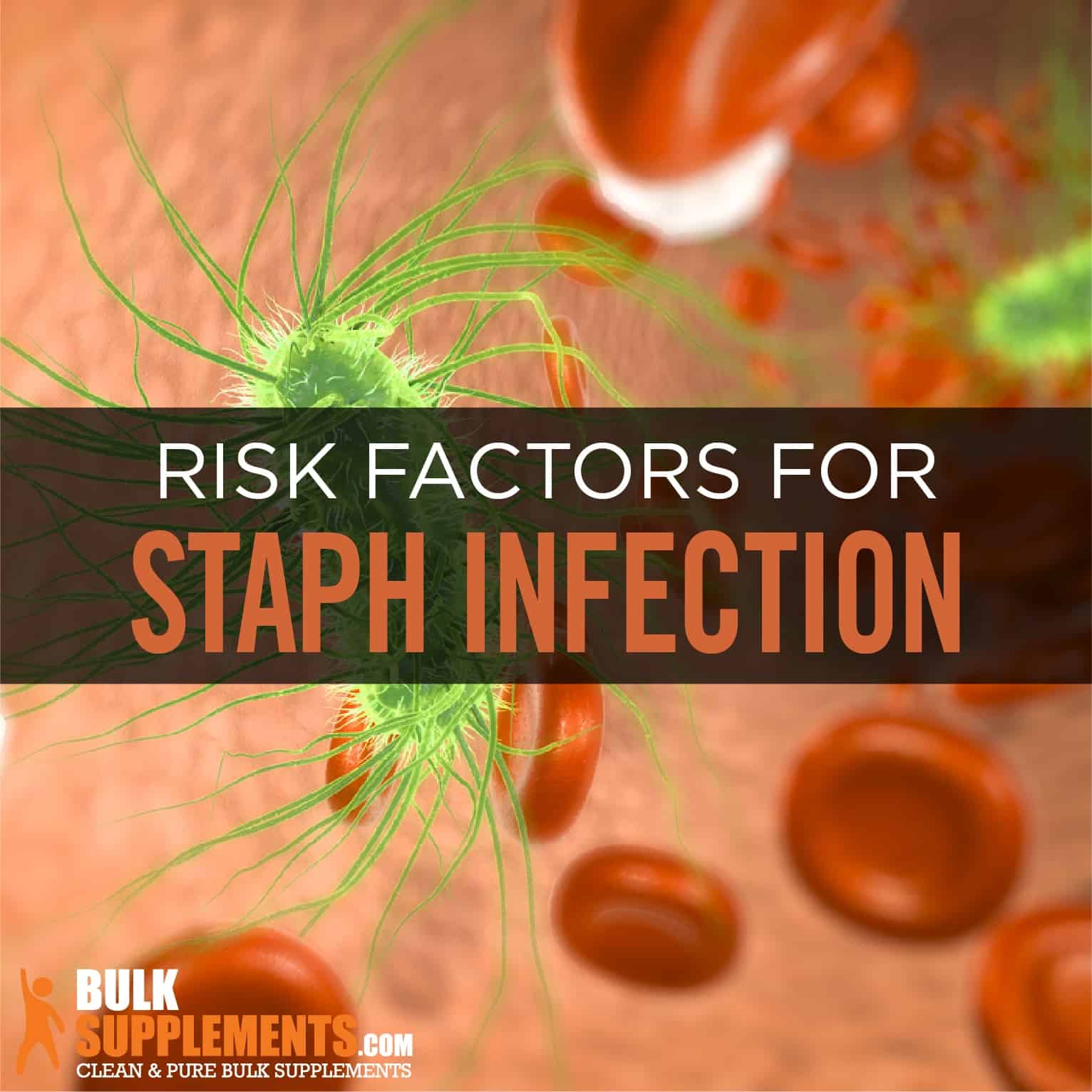What is a Staph Infection?
Staph infections result from Staphylococcus aureus (staph), a family of bacteria that cause a multitude of diseases. Staph bacteria commonly live on your body already — on the skin and in the nose and armpit — without causing infection, even in healthy individuals. But the bacteria cause illness when they manage to invade your body through punctured skin or the gut from contaminated food. (x)
If you harbor the bacteria without showing symptoms, you act as a carrier of the infection. It may spread to other people. Most staph germs spread from skin-to-skin contact. Staph infections can take many forms, varying in symptoms and severity. Infections can be mild skin reactions or life-threatening conditions. (x)
Types of Staph Infections
Staph infections present themselves in different ways. They can cause skin infections, food poisoning, bloodstream infections, endocarditis (damage heart tissue), pneumonia and toxic shock syndrome (TSS). (x) (x)
Skin Infections
Diagnosing skin infections is essential to ward off any possibility of the disease spreading on your body or infecting others. Staph skin infections include:
- Folliculitis
Folliculitis is an infection in the hair follicles in which minute white-headed pimples surface at the base of hair shafts. Aside from an itch and slight pain, the person does not feel sick. (x)
- Cellulitis
Cellulitis is a deeper infection under the skin’s surface. It causes red, painful swelling on the skin and sometimes ulcers that ooze open with discharge. The skin usually looks pitted, is warm and tender to touch, and fever with chills might develop. (x)
- Boils
Having a boil on the skin is the most common form of a staph infection. The abscess is a swollen, red, painful lump filled with pus that forms in an infected hair follicle or oil gland. Boils mainly develop where tiny hairs become irritated, such as the groin and under the arms around the buttocks. (x)
- Impetigo
Impetigo is most common in children. It is a painful rash with a crusted yellow coating that oozes fluid. Doctors prescribe antibiotics to prevent long-term health concerns and protect others. (x)
- Staphylococcal Scalded Skin Syndrome
This condition primarily affects infants or babies, characterized by fever, a rash and blisters that rupture and expose a new surface that looks similar to a burn. (x)
Health Concerns Associated with Staphylococcus
Staph bacteria can have an all-encompassing effect on your body when it’s infected. You must see your doctor if you suspect an infection. Some of those health concerns include:
- Food Poisoning
Staph bacteria cause most cases of food poisoning. Symptoms include dehydration, nausea, vomiting, low blood pressure and diarrhea. They usually appear and disappear quickly. (x)
- Bloodstream Infections
When staph bacteria enter your bloodstream, it interferes with vital organs like the heart, brain and lungs. It can also affect the bones and muscles. The symptoms include fever and low blood pressure. (x)
- Endocarditis
Endocarditis attacks your heart’s inner lining and interferes with normal blood flow, causing damage to the kidneys and lungs. It can cause symptoms like congestive heart failure. (x)
- Pneumonia
When the staph bacteria enter the lungs or the surrounding tissues, it causes pneumonia. Usually, the lungs can defend themselves against these bacteria when someone inhales them. But if your defense mechanisms are not functioning correctly, or if you inhale too many bacteria, your lungs can get infected. (x)
- Toxic Shock Syndrome (TSS)
TSS is a life-threatening condition caused by toxins from staph bacteria. Symptoms include diarrhea, confusion, fever, abdominal pain, muscle aches and a rash on your hands and feet. The bacteria can spread after surgery, from skin wounds and from wearing specific types of tampons for extended periods. (x)
- Septic Arthritis
When staph bacteria target your joints and cause inflammation, it leads to septic arthritis. As a secondary infection, symptoms include fever, pain, and swelling in the joints. (x)

Risk Factors for Staph Infections
Staph bacteria live naturally in your body and rarely cause complications. However, certain factors and behaviors allow the bacteria into the body to cause infection. Some of these factors include:
- Health Conditions
Certain health conditions can increase the risk of developing a staph infection, as well as the methods that treat them. Diabetes, HIV/AIDS, dialysis for kidney failure, lung disorders, respiratory illnesses, autoimmune disorders and cancer that require chemotherapy are all risk factors that increase the risk of staph infection. People with open wounds such as burns, cuts, stitches and incisions are also at risk if you don’t clean or appropriately treat them. (x)
- Hospitalization
You can find staph bacteria in hospitals, putting you as a current or recent patient at threat for infection, especially if you have a weak immune system, burns or surgical wounds. Even if you are not a patient, spending time in hospitals where the bacteria can spread from one patient to another is a risk factor. (x)
- Contaminated Food
Although it looks and tastes normal, food with toxins from staph bacteria causes food poisoning. If you don’t store food correctly, it can become a breeding ground for staph bacteria. And if food handlers don’t wash their hands properly, it can transfer from their skin to the food. (x)
- Invasive Devices
If someone has an artificial device or joint in their bodies, staph bacteria can form around them and penetrate the bloodstream through surgical incisions. Devices like dialysis tubes, catheters, feeding and breathing tubes can allow bacteria into the body. (x)
- Prolonged Tampon Use
Failing to change your tampons regularly could cause toxic shock syndrome (TSS). If left in too long, the tampon can harbor staph bacteria. It gets into your bloodstream because of vaginal irritation from the tampons. (x)
Treatment for Staph Infections
Doctors use a physical exam to observe your symptoms and diagnose a staph infection. (x) They may also use a blood, urine, imaging or culture test depending on the type of infection.
Antibiotics treat staph infection. They may be a cream, oral, ointment or intravenous medication. (x) Nafcillin, sulfa drugs and vancomycin are common prescriptions to treat the infection. (x) However, methicillin-resistant Staphylococcus aureus (MRSA) is immune to some antibiotics. Without treatment, MRSA can develop into sepsis. (x)
If the infection affects your skin, the doctor will open up the wound in order to drain any fluid and reduce inflammation. But if the infection enters your body through an invasive device or affects a bone, it needs to be removed immediately. (x)
Natural Remedies for Staph Infections
There are also natural treatments that research claims are effective in treating staph infection. For example, coconut oil will help boost the immune system so that it will fight off infections. It also has strong antibacterial properties and can treat infections. (x) (x) Tea tree oil and oregano oil have anti-inflammatory and antibacterial functions that effectively treat wounds such as staph infections. (x) (x)
Preventing Staph Infections
There are precautions to avoid staph infections and keep the bacteria from entering the body. They include: (x)
- Clean and bandage open cuts, wounds, burns and rashes
- Handle and store food properly
- Practice good hygiene and wash hands regularly
- Reduce tampon risk by using low absorbency and changing them frequently
- Boost the immune system with supplements like zinc, antioxidants like vitamin C and antiviral herbs like astragalus and calendula
Supplements for Staph Infections
Staph infections are serious, and if you think you might have a bacterial infection, see your doctor immediately. Any new supplements you want to try should be discussed with your physician. Some supplements to help with staph infections include:
- Cranberry Extract Powder
With essential nutrients packed in cranberry extract, it has antioxidants and helps support bladder health. Its antimicrobial effects report effectiveness against Staphylococcus aureus. (x) As a dietary supplement, take 400 mg of cranberry extract powder one to three times a day with water.
- Dandelion Root Extract Powder
Although researchers are still searching for evidence of using dandelion root in food and drinks to promote overall health, the recommended dosage is 1,000 mg twice a day.
- Garlic Extract Powder
The active ingredient in garlic is allicin, which has antibacterial properties. Garlic extract also has B and C vitamins. The recommended serving size is 650 mg twice a day with food. A study performed on tainted hamburger meat proved the extract decreased the growth of staph bacteria. (x)
- Echinacea Extract Powder
With anti-inflammatory, antioxidant and antimicrobial properties, echinacea extract helps support the immune system and overall health. Take 450 mg once or twice a day.
- Grapefruit Seed Extract
A multipurpose supplement, grapefruit seed extract has antioxidant properties and can promote gastrointestinal health. Take 250 mg twice daily. A study conducted under a strict environment known as a biofilm formation housed four strains of bacteria — two staphylococcus and two Escherichia strains. Grapefruit seed extract entered the biofilm and created significant changes, meaning the extract is an effective agent against these two strains of bacteria. (x)
Where to Buy Extracts or Supplements for Staphylococcus (Staph) Infections?
You can purchase these extract powders and supplements for staphylococcus infection at BulkSupplements.com. The company is an industry-leading manufacturer and distributor of pure dietary supplements.
BulkSupplements.com is not just a consumer brand. It also supplies pure ingredients to other food and supplement brands to make their products. All products at BulkSupplements.com are manufactured and tested according to current and proper manufacturing practices.
Are you interested in trying any of these extract powders or supplements mentioned in this article as a possible solution to helping you with staphylococcus infection? Contact BulkSupplements.com to place an order today.
The Bottom Line
Staphylococcus aureus bacteria cause staph infections. The bacteria live on the skin naturally, usually without harm. But it causes disease if it enters the body.
Risk factors for infection include hospitalization, surgery, contaminated food, a weakened immune system and prolonged tampon use. The bacteria can cause skin infections, food poisoning, bloodstream infections, endocarditis, pneumonia or toxic shock syndrome (TSS). Staph infections can affect the lungs, skin, joints, bones and blood vessels.
You can ward off staph infections with behaviors like washing hands, proper food handling and storage, cleaning and bandaging wounds and reducing tampon use and absorbency. Supplements and essential oils like oregano, tea tree oil and coconut oil can also help.
These statements have not been evaluated by the Food and Drug Administration. These products are not intended to diagnose, treat, cure or prevent any disease.


